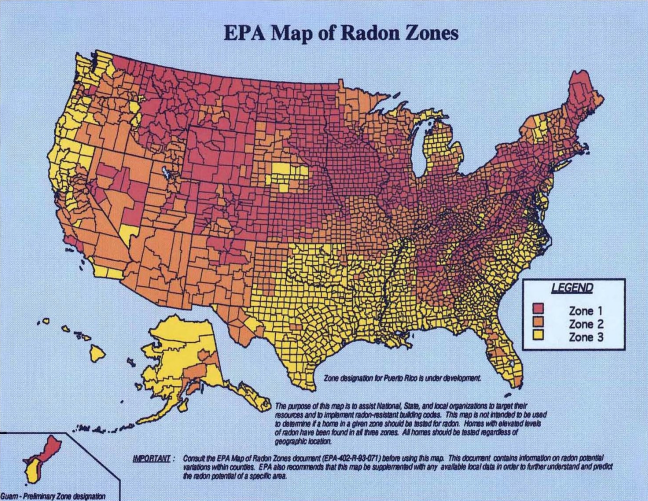
The Invisible Killer Beneath Our Homes - How Radon Became America’s Quietest Public Health Crisis
"The Invisible Killer Beneath Our Homes: How Radon Became America’s Quietest Public Health Crisis"
At first, Robbins thought it was allergies. A dry cough, some wheezing. Then fatigue crept in. By the time her doctors diagnosed stage 4 lung cancer, Robbins—a 42-year-old mother of two from suburban Utah—was told she might have months to live.
She had never smoked a day in her life.
Puzzled, her medical team began to probe environmental exposures. A radon test of her home revealed the shocking truth: the gas levels were more than ten times the Environmental Protection Agency’s recommended limit. According to calculations used by health authorities, Robbins had been breathing the radioactive equivalent of three packs of cigarettes a day.

Today, Robbins is still alive, a rare survivor and an unlikely advocate. She travels across the Mountain West with a simple message: you need to test your home.
But most Americans haven’t—and likely never will. Despite causing an estimated 21,000 deaths annually, radon remains largely absent from public discourse, regulation, and real estate transactions. And unlike carbon monoxide or lead paint, radon leaves no smell, no taste, no immediate symptoms. It is a silent, invisible intruder—and one of the most overlooked environmental hazards in America.
Table summarizing how radon forms and enters homes.
| Aspect | Details |
|---|---|
| Formation of Radon | Radon is a radioactive gas formed from the natural decay of uranium in soil. |
| Entry Pathways | - Cracks in floors, walls, and foundations |
| - Gaps around service pipes and construction joints | |
| - Basements, crawlspaces, and sump pumps | |
| - Well water from groundwater sources | |
| Influencing Factors | - Air pressure differentials (e.g., ventilation or temperature changes) |
| - Soil moisture and weather conditions | |
| Health Risks | Second leading cause of lung cancer due to prolonged exposure. |
| Prevention | - Test homes for radon levels |
| - Seal cracks and gaps | |
| - Install radon mitigation systems (e.g., ventilation systems) |
A Gas With No Warning and Few Rules
Radon is an inert, radioactive gas released by the natural decay of uranium in soil and rock. It seeps into buildings through cracks in foundations, crawl spaces, and basements. Once trapped indoors, it accumulates. You can’t see it. You can’t smell it. But over time, it embeds itself into lung tissue, delivering radioactive blows that mutate cells and spark cancer.

Did you know that radon exposure is estimated to cause approximately 21,000 lung cancer deaths annually in the United States? This makes radon the second leading cause of lung cancer overall and the leading cause among non-smokers. Radon-related lung cancer ranks 9th among all cancer types in terms of mortality, highlighting its significant impact as the leading environmental cause of cancer deaths in the U.S. Despite being a silent threat, awareness about radon exposure can help mitigate its risks through testing and mitigation in homes and buildings.
Yet in the public imagination—and in the eyes of many lawmakers—radon barely registers. “People worry more about what’s in their drinking water or in their air from factories,” one environmental health researcher noted, “but this is already in their homes, quietly causing damage.”
Even more troubling: many of the EPA’s safety thresholds are based on decades-old data. Newer studies, including a recent analysis of 727 U.S. counties led by researchers at Oregon State University, suggest the danger begins at much lower levels than previously believed. That study found even moderate radon exposure—below current EPA guidelines—was associated with increased risks of childhood leukemia.

Table: EPA Radon Zones by County in the United States, indicating areas with varying potential for elevated indoor radon levels.
| Zone | Color | Radon Potential | Average Indoor Radon Levels |
|---|---|---|---|
| Zone 1 | Red | Highest | Greater than 4 pCi/L |
| Zone 2 | Orange | Moderate | Between 2 and 4 pCi/L |
| Zone 3 | Yellow | Lowest | Less than 2 pCi/L |
Still, few states require radon testing for homes, schools, or workplaces. Regulations vary wildly—some mandate disclosure during home sales; others are silent. The result is a patchwork of protection, where a child in Illinois may be shielded by law, while one across the river in Missouri is left vulnerable.
The Architecture of Neglect
To understand why radon has remained in the shadows, you have to understand the systems that allow it to persist. Start with housing.
In most U.S. real estate markets, radon testing isn’t required during home sales. Even when levels are found to be high, mitigation isn’t mandatory. Buyers and sellers negotiate it like a broken appliance—if at all. “It’s often treated as optional,” a home inspector from Pennsylvania explained. “People just want to close the deal.”

The cost of fixing a radon problem—typically $1,200 to $2,500—can deter lower-income homeowners from taking action, especially if the gas is invisible and abstract. There are no emergency symptoms, no urgent alarms. Just a long, slow accumulation of risk.
Summary of Typical Costs for Professional Radon Mitigation System Installation
| Component | Cost Range | Description |
|---|---|---|
| Radon Fan | $200–$400 | Essential for active systems |
| Piping | $100–$200 | Required for system installation |
| Crack Sealer | $50–$100 | Used to seal entry points |
| Labor | $600–$1,000 | Installation and setup costs |
| Electrical Work | $300–$500 | If additional electrical connections are needed |
| Permits | $25–$150 | Local permits for installation |
| Testing | $150–$300 | Pre- and post-installation testing |
| Pressure Field Testing | ~$150 | Optional, depending on home conditions |
| Foundation-Specific Costs | $900–$8,000 | For crawlspaces or unique foundations |
| Ongoing Costs (Electricity) | ~$5–$10/month | Monthly electricity cost for the fan |
| Ongoing Costs (Maintenance) | ~$10–$20/month | Regular maintenance and monitoring |
Building codes rarely help. Only a handful of jurisdictions require radon-resistant construction in new homes. In older buildings—particularly schools and multifamily housing—the issue is even more dire. Testing is sporadic. Mitigation systems, if they exist, are often poorly maintained.
Compounding the problem is a fundamental mismatch in incentives. Builders, landlords, and sellers don’t suffer the health consequences of radon exposure. Tenants and future homeowners do. Without regulatory pressure or financial incentives, the status quo—benign neglect—prevails.
A Broader, Hidden Cost
Radon’s toll isn’t just human. It’s economic.
Lung cancer is among the most expensive cancers to treat in the U.S., with costs averaging over $150,000 per patient. While smoking remains the leading cause, radon-induced cancers disproportionately affect nonsmokers—particularly women and the elderly.
The estimated annual healthcare costs associated with radon-induced lung cancer in the United States are approximately $6 billion. This figure includes medical expenses for treatments like surgery, chemotherapy, and radiation therapy, as well as indirect costs such as loss of productivity and premature deaths. Radon exposure is responsible for about 21,000 lung cancer deaths annually, making it a significant public health issue
A 2024 study published by the American Academy of Neurology added an unexpected twist: long-term radon exposure was linked to a 14% increased risk of stroke in older women, even at levels below the EPA’s action threshold. Though more research is needed, the finding challenges the idea that radon’s damage is limited to the lungs.
Still, public funding for radon mitigation remains anemic. Federal radon programs have seen budget cuts over the years, while state-level efforts depend heavily on local priorities and grant cycles. The result is predictable: a problem large enough to kill tens of thousands every year is left to individual homeowners with patchy guidance and no federal mandate.
The Irony of Invisibility
Ironically, one reason radon has evaded attention is that it doesn’t cause sudden mass casualties or social panic. It’s not a virus. It doesn’t trigger asthma attacks or send people to the ER in clusters. It kills slowly, statistically, and often indistinctly—its victims folded into broader cancer or stroke data.
Did you know that the U.S. Environmental Protection Agency (EPA) sets an "action level" for radon at 4 picocuries per liter (pCi/L)? This threshold indicates when radon levels in a home or building are high enough to warrant remedial action to reduce exposure. Even levels below 4 pCi/L carry some risk, and the EPA suggests considering mitigation for levels as low as 2 pCi/L. Radon is a significant concern because it increases the risk of lung cancer, and reducing exposure can help protect health. Regular testing and mitigation measures, such as soil suction systems, can help lower radon levels and minimize risks.
This invisibility lends itself to a vicious cycle. Without media attention, public demand for testing and reform remains low. Without public demand, political will withers. And without regulation, the next generation of homes and schools are built on the same faulty foundation.
Meanwhile, the science keeps moving. In a presentation at the 2024 American Thoracic Society conference, researchers described a rare case of advanced pulmonary fibrosis linked to chronic radon exposure. Though causality is harder to pin down in such conditions, the case underscores what experts have long warned: radon may have far more diverse and insidious health effects than previously realized.
A Path Forward—If We Choose to Walk It
Some solutions are obvious. Home testing kits are cheap, often under $20. Mitigation systems are effective and widely available. Retrofitting schools and public buildings could save lives and money in the long run. But none of this happens without political will and public pressure.

Advocacy groups are pushing for change. The American Lung Association supports mandatory testing in real estate transactions. Some local governments, such as in Illinois and parts of New Jersey, now require radon-resistant construction. Others offer financial assistance for mitigation.
But these are exceptions. What experts are calling for—what Robbins and others like her are begging for—is a national, coordinated response. Something akin to the seatbelt laws of the 1980s or the lead paint regulations of the 1970s. Something that acknowledges radon for what it is: a common, preventable, and deadly hazard.
There are echoes here of past environmental failures. Like asbestos, whose dangers were long known but slow to be addressed. Like lead, which poisoned generations before a critical mass of science and activism forced action. In each case, the science was ahead of the policy. And people paid the price in the meantime.
The Responsibility of Knowledge
We often think of public health threats as emerging from outside—from chemical spills, viral pandemics, or industrial disasters. But radon reminds us that danger can be homegrown, literally. It rises from the earth beneath our feet and fills our homes silently.
What makes it tragic is not just the harm it causes, but how avoidable that harm is. With better testing, smarter policies, and public education, thousands of lives could be saved each year. But unlike other risks, radon won’t trigger a visible crisis. It requires action before disaster. It requires imagination and empathy.
Robbins sometimes reflects on the irony that her cancer might have been prevented by a $15 test kit. “If I had known, I would have done something,” she says. Her voice is calm, but her eyes carry the weight of knowing.
That is the final cruelty of radon: not just that it kills, but that it does so amid our ignorance—until someone like Robbins, struck by misfortune, steps forward and breaks the silence.
If your home has never been tested for radon, it may be time. Not because there is panic, but because there is proof.